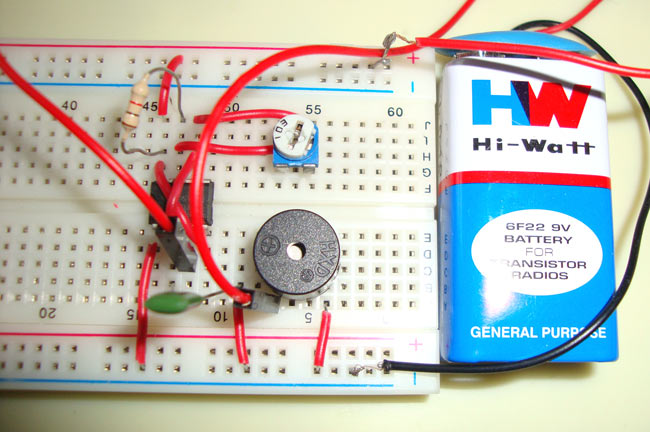
Various mosquito repellent solutions like coils, liquid vaporizers, and creams, all have possible adverse effects to health. Then there are electronic mosquito repellents available in market which are equally efficient and relatively safer. The concepts of these mosquito repellers are simple and we can build a simple mosquito repellent circuit at home easily by using 555 timer IC and few other commonly available components. Let’s see the concept of mosquito repellent circuit in detail.
The concept that we are going to use in out circuit is related to ultrasound. A sound with frequency higher than 20 kHz is termed as “Ultrasound”. For we humans a sound only ranging between 20 Hz to 20 kHz frequency is audible, and any sound with frequency below or higher than this range wouldn’t be audible for us. But there are various animals and insects (including mosquitos) that could hear the ultrasound. Generally ultrasound in a range of 20 kHz to 40kHz is transmitted by male mosquitoes and received by female mosquitoes, however after breeding female mosquitoes tend to avoid male mosquitoes and so they tend to avoid ultrasound in that range. As we know that only female breeding mosquitoes bites humans, we can use this concept and can design a circuit which produces the ultrasound in frequency range specified above.
So here we are going to design a simple mosquito repellent circuit which will be producing a sound of approximately 40 kHz.
Required Components
555 Timer IC
Buzzer
Resistors - 1k and 1.3k (variable resistor of 10k)
Capacitor - 0.01µF
Battery - 9v
Breadboard and connecting wires
Circuit Diagram and Explanation
As shown in the above diagram, we have designed a circuit using 555 timer IC in Astable mode to produce 40 kHz frequency sound. We have connected Buzzer at the output (PIN 3) of the 555 timer IC so that a sound of desired frequency can be generated. We should note here that we need a HIGH frequency Piezo buzzer, so that a high frequency sound can be generated. Also note that we might not be able to hear the sound, generated by the circuit as it is beyond our audible range.
We can calculate the value of resistors and capacitor to produce oscillation of 40KHz frequency by given formulae:
F = 1.44 / ((R1+R2*2)*C)
In our case we have used:
R1= 1K
R2(RV1) = 1.3 K (variable resistor of 10k, set at 1.3K with the help of multimeter)
C = 0.01uF
So now
F = 1.44 / {(1 + 2*1.3)*1000} * 0.01uF
F = 1.44 * 100000 / 3.6 = 40000 = 40KHz
We can increase the value of resistor R1 or R2 to decrease the frequency.
Comments
What problem are you facing? Please, tell us precisely. You might feel a continuous very fine beep/sound.
Where did you find a high frequency piezo buzzer?
Sir,
What is the range of this system or how much area will it cover
Sir,
Please tell that how to troubleshoot circuit as the sound from the buzzer is audible and circuit is unable to produce ultra sound so please clear the fault in the circuit as soon as possible .........
I connect component properly but there are not effect on mosquito?
@Baberullah @taranjeet: Try with some different frequencies and use high frequency Buzzer.
whats difference between killer and repellent?
exclusive project it is very useful for us
Susy,its working but mosquitoes are not going away. How did u put frequency of variable resister. Please answer this?
Sir,
is the buzzer continious ?
Yes, but you will not able to hear the sound, some times you can feel very fine buzzing sound.
Sir Will It Work?
Sir, how we can know the range to which extent mosquitoes are repelled.Is there any way to improve the range
It should be sufficient for a normal size room.
The range should be in 20-40khz ..u can increase the range of frequency by cycloconverter
Please if this really worked for anyone
can i get the conclusion of the ckt
In the circuit diagram the sign of the capacitor (0.01uF), it seems that it is polarized. Now my question is, is it really polarized? Because in the picture you have used a ceramic capacitor.
Though I set everything properly, I can hear a loud sound from the buzzer.
Sir !
May i know the values of piezo buzzer value ...
how can we set the exact potentiometer at "1.3k"
Sir, i made it properly and when I change the frequency of variable resister lheard a small sound but mosquitoes didn't go far away. Why is it?
hi can you send circuit of radio freequency rc boat
I real need come circuit
nice work
can i use a 0.01uf ceramic capacitor?
Sir, I have proteus software and now I want to test the circuit after stimulating it.How can I determine errors if any in the circuit.Plz help sir
How to choose correct buzzer to emit 40KHZ signal and what are the requirement (spec) for it
Can i use this for RAT repellent in car ?
GIVE CLEAR EXPLANATION
ALSO GIVE ME RANGE OF THE CIRCUIT
I'm Successful in making of Mosquito repellent as per the given Circuit diagram....thank you Circuit Digest
And is it effective as well?? I mean any reduction in mosquitos?
The cct diagram is not explanatory enough, pls explain the cct diagram more
Sir, is it effective???
and if its effective then tell me please how much percentage u can say
I have been trying to simulate this using proteus. I cant hear the sound of the buzzer. is it becauseof the same reason that the frequency is very high.







can you suggest me how to trouble shoot this circuit, though i set everything properly i can listen the sound of my buzzer, please help me